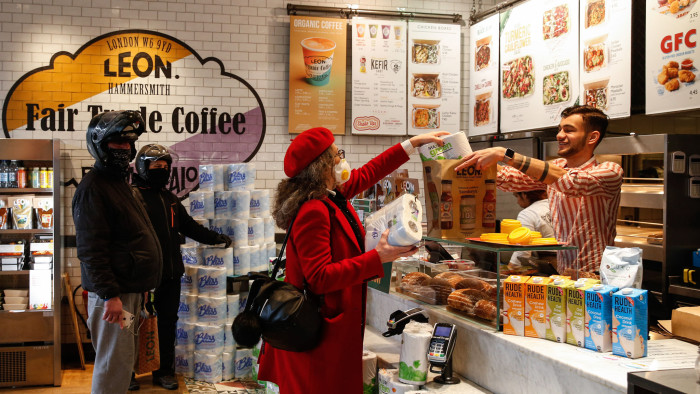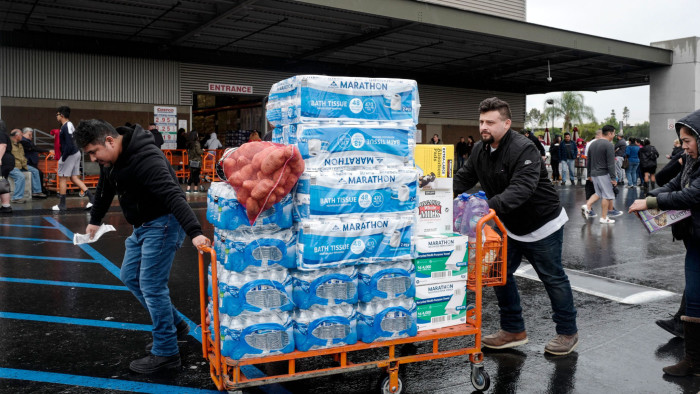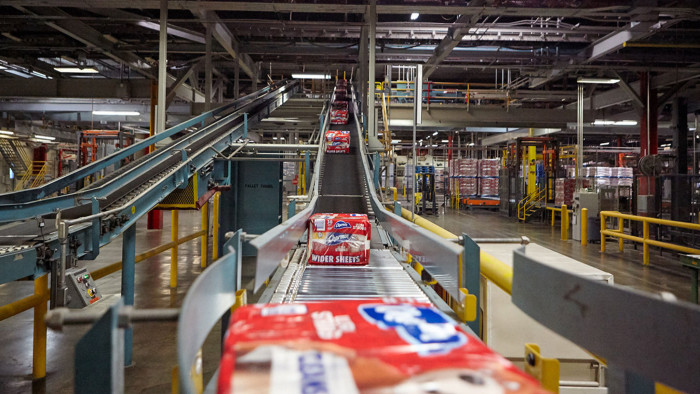Restaurants and hotels clean up with toilet paper sales

Simply sign up to the Retail & Consumer industry myFT Digest -- delivered directly to your inbox.
In an effort to keep trading during the coronavirus pandemic, Old Ebbitt Grill, one of Washington DC’s oldest restaurants, began serving takeaways. Its menu, which usually offers oysters and steaks to tourists lunching across from the White House, now features a new item: toilet paper, costing $2.50 a roll and limited to two per order.
As the Covid-19 panic-buying empties supermarket shelves of toilet paper, many restaurants, hotels and offices — devoid of their usual visitors — are flush with it.
Leon, a restaurant chain that usually focuses on selling flat whites and halloumi wraps to passing office workers, says it started offering toilet rolls with online orders when it realised customers were struggling to find them in supermarkets.
“Meanwhile, with restaurants, bars and hotels closed, the hospitality supply chain has been sitting on an abundance of [toilet roll] stock,” says Glenn Edwards, managing director of Leon’s US division.
Nielsen, which measures supermarket data, reported a 71 per cent year-on-year increase in US retail toilet paper sales in the nine weeks to May 2.
Although some of this increase can be attributed to reports of widespread hoarding as the coronavirus pandemic took hold, analysts say much of the demand for supermarket toilet roll is down to the fact that consumers are spending more time at home.
Georgia-Pacific, a US maker of toilet paper for both commercial and retail sale, estimates that working from home increases household toilet roll usage 40 per cent.
According to data provider Statista, US toilet paper consumption is the world’s highest, with Americans buying more than 7bn rolls each year, equating to 141 rolls per person. This outstrips the 134 rolls used annually per person in Germany, 127 in the UK, 88 in Australia, 71 in France and 49 in China.
Georgia-Pacific says that while recent demand from hotels and restaurants has decreased, it is preparing for a rebound as cities across the US begin to reopen.

Procter & Gamble, the household products conglomerate, is one of the three biggest producers of toilet paper in the US. Its Charmin brand of toilet roll is one of many household items that has seen higher demand during the coronavirus pandemic, as people spend more time at home.
“As the pandemic unfortunately developed in the US and Europe as the quarter progressed, demand surged,” Jon Moeller, chief operating officer and chief financial officer, said last month when P&G reported its biggest quarterly profit for decades. The company said it had boosted toilet paper production in an effort to meet heightened demand.
“[Household] products are more important than ever given the needs presented by the current crisis, the increased awareness around health and hygiene, and the additional time many of us are spending at home,” Mr Moeller added.
Rick McLeod, P&G’s family care product supply vice-president, says demand for Charmin is at “record levels”.
“We’re seeing very clearly that consumers view our products as essential,” says Mr McLeod. “People are going to be using our products at home, rather than at hotels or restaurants.”
By narrowing production to its most popular brands and packet sizes — which minimises factory line stoppages — P&G has boosted its toilet paper output to cope with heightened demand.
Georgia-Pacific also increased toilet paper output, producing 1.5m extra rolls a day. The company is bypassing distribution hubs by shipping toilet paper directly to supermarkets, which Georgia-Pacific says has cut its delivery times “by up to three days”.
The American Forest and Paper Association says 700,000 tonnes of tissue and toilet paper was produced by US paper mills in March, the highest monthly total since the association started collecting data in 2007.

Toilet paper manufacturers say that rolls made for commercial venues sometimes differ from paper sold through supermarkets for home use, meaning that consumers may have to adapt to a different product.
While commercial toilet roll is sometimes produced in larger sizes — often for use in dispensers — paper for home use is more likely to be made of softer, higher grade tissue, and may be decorated, scented or “contain emollients and lotions for added comfort and desirability”, according to the American Forest and Paper Association.
But despite the increased production, there remain many empty supermarket shelves across the US, with restaurants and cafés increasingly seeing a valuable side income in selling their spare toilet roll via delivery apps.
In Washington, one popular delivery app lists 52 restaurants offering takeaway toilet paper. As well as toilet roll, Old Ebbitt Grill and several of its rival restaurants also sell reusable homemade face masks and hand sanitiser.
“It continues to be a nightmare for people to buy toilet paper,” maintains Leon’s Mr Edwards.

Comments